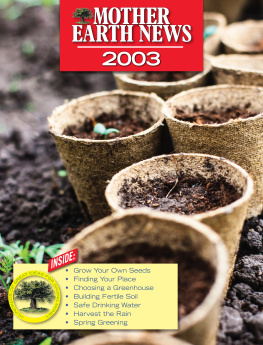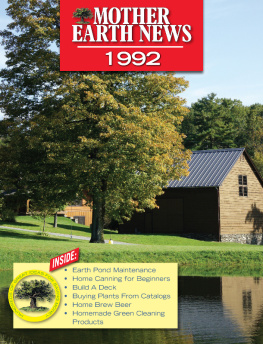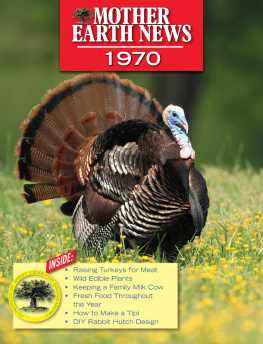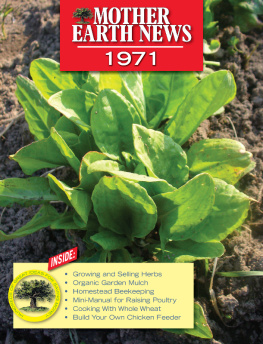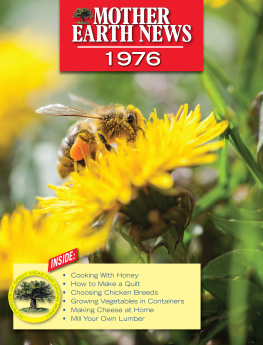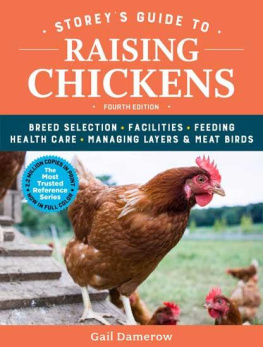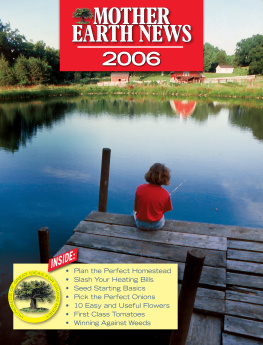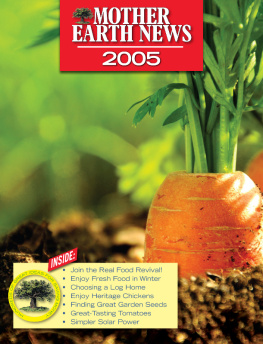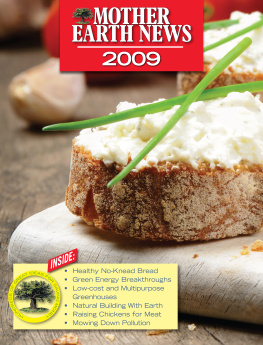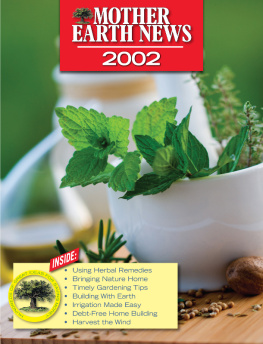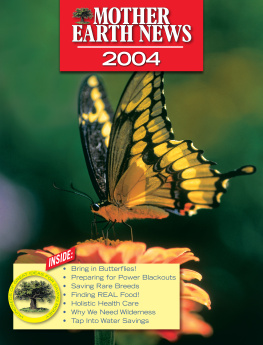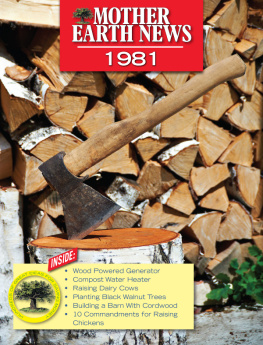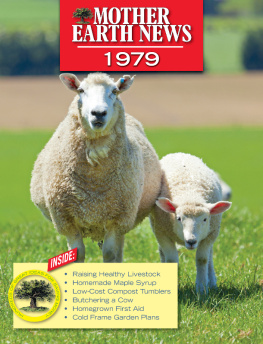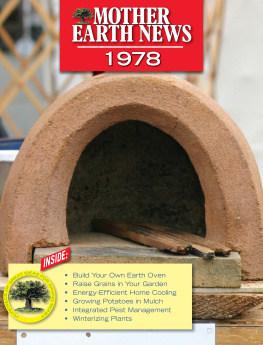Mother Earth News - Mother Earth News 2003
Here you can read online Mother Earth News - Mother Earth News 2003 full text of the book (entire story) in english for free. Download pdf and epub, get meaning, cover and reviews about this ebook. year: 2003, publisher: Mother Earth News, genre: Science / Home and family. Description of the work, (preface) as well as reviews are available. Best literature library LitArk.com created for fans of good reading and offers a wide selection of genres:
Romance novel
Science fiction
Adventure
Detective
Science
History
Home and family
Prose
Art
Politics
Computer
Non-fiction
Religion
Business
Children
Humor
Choose a favorite category and find really read worthwhile books. Enjoy immersion in the world of imagination, feel the emotions of the characters or learn something new for yourself, make an fascinating discovery.
- Book:Mother Earth News 2003
- Author:
- Publisher:Mother Earth News
- Genre:
- Year:2003
- Rating:4 / 5
- Favourites:Add to favourites
- Your mark:
- 80
- 1
- 2
- 3
- 4
- 5
Mother Earth News 2003: summary, description and annotation
We offer to read an annotation, description, summary or preface (depends on what the author of the book "Mother Earth News 2003" wrote himself). If you haven't found the necessary information about the book — write in the comments, we will try to find it.
Mother Earth News 2003 — read online for free the complete book (whole text) full work
Below is the text of the book, divided by pages. System saving the place of the last page read, allows you to conveniently read the book "Mother Earth News 2003" online for free, without having to search again every time where you left off. Put a bookmark, and you can go to the page where you finished reading at any time.
Font size:
Interval:
Bookmark:

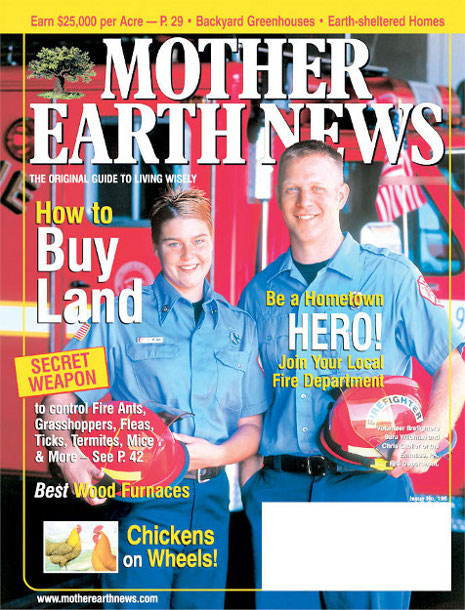
Few people know that honeybees (Apis mellifera) are not native to the Americas, but were brought over by Europeans. Before these bees came to this country, pollen bees, also called native, wild or non-Apis bees, were responsible for pollinating our flowering plants.
Even though they dont live together in hives, and the females make their own simple nests and care for their own offspring, pollen bees are still somewhat social creatures that dont mind nesting together in close quarters. You can foster a bee collective by providing them with nesting blocks. (For more information, see the article at left.)
Some pollen bees adult activity coincides with the flowering period of their food plants, making them suited for management with crops that have brief blooming periods. This quality, paired with their gentle nature and resistance to mites and viruses, makes them fantastic orchard and garden pollinators, and perfect for many backyard gardeners.
More information on pollen bees can be found at the Pollinator Paradise Web site: www.pollinatorparadise.com.
Before you take that next forkful of food, be thankful. Or rather, bee thankful. Every third bite of food we eat, as well as most of our clothing, some beverages and many medicines, could not be produced without the essential pollination provided by bees, according to research entomologist Stephen Buchmann.
But native bees and other pollinators are in crisis. Their populations are plummeting due to habitat destruction and fragmentation, and due to the widespread use of pesticides on farms and lawns.
The U.S. Fish and Wildlife Service reports that more than 50 pollinator species are threatened or endangered; wild honeybee populations have nose-dived, declining by 25 percent since 1990. Not only does this spell peril for pollinators and plants, but it also negatively affects the human food supply. Pollinators are critical in the production of more than 150 food crops in the United States - from apples to alfalfa. Honeybee shortages in California caused by parasites and pesticides required almond growers to import bees to pollinate their crop. Worth $800 million, thats nothing to sneeze at.
Its no exaggeration when researchers point out that our food - and our future - relies on pollinators. The good news is that you can take steps to encourage pollinator populations in your own back yard. The steps are simple, and the rewards are fruitful. While youre helping them, theyll be helping your fruit and vegetable crops be the best they can bee. For example, studies have shown that ample bee pollination can increase strawberry fruit size by 40 percent. To attract more pollinators:
Provide nesting blocks for pollen bees. Habitat for these bees can be as simple as 5/16-inch holes drilled into an old log or small blocks of wood (visit the U.S. Department of Agricultures Bee Biology and Systematics Laboratory Web site at www.loganbeelab.usu.edu/) or you can purchase pre-drilled blocks from Fedco (www.feedcoseeds.com) and other garden product suppliers.
Lose your lawn. Create your own pollinator-friendly garden by planting a variety of native flowering plants. The Lady Bird Johnson Wildflower Center offers lists of native flowering plants and links to local native plant societies [(512) 292-4200 or www.wildflower.org] .
Use organic pest-control methods, not pesticides. Common-Sense Pest Control by William Olkowski is a veritable treasure trove of information on least-toxic techniques.
Make habitat for pollinators and other wild critters. The U.S. Department of Agricultures Conservation Program [(888) LANDCARE or www.nrcs.usda.gov/feature/backyard/wildhab.html] gives valuable tips on establishing beneficial back yards. Also see The National Wildlife Federations Habitat Program Web site [www.nwf.org/backyardwildlifehabitat] , where you can keep track of your own back yards development and learn about species native to your area. Last but not least, support growers who use pollinator-friendly practices and buy organic food as often as you can.
Busy, Busy Bees. To make just one pound of honey, worker honeybees travel 55,000 miles and source 2 million flowers.
Grow food for the table - and the spirit - any time of year
What gardener doesnt dream of having a greenhouse? Dozens of greenhouse kits can be found on the market (see the chart below), or you can build your own from scratch (see Building a Hoophouse). Either way, youll have a warm, fragrant place to play and plenty of fresh food and flowers right through the winter.
Prices on greenhouse kits vary widely, depending upon the type of glazing provided. Kits with polyethylene film can cost less than $200, while a kit using much more durable and better-insulating polycarbonate can cost $4,000. Heres what you need to know before you buy or build, including a detailed discussion of various glazing options.
The most expensive component in many greenhouses is the glazing material. The better the glazing, the more expensive the greenhouse. Glazing permits the entry of light and solar heat into the structure. An array of choices exists for glazing, including glass, vinyl, fiberglass, polycarbonate, acrylic and polyethylene. The materials vary in cost, ease of application, solar performance and longevity.
Whatever glazing material you buy should be made specifically to withstand the sun over many years without losing clarity. Virtually all plastics eventually break down (they either turn yellow or white and/or become brittle) when exposed to the suns ultraviolet light, limiting the amount and quality of light that enters the greenhouse. Even so, some plastics are a sensible choice; many are guaranteed for 20 years. Some plastics are many times stronger than glass. Where I live in Wyoming, hail occurs an average of 10 times a year, so glass is not a good choice. For our specific climate and budget, I choose polycarbonate. There are many pros and cons to consider in selecting the right glazing. Often the No. 1 deteminant is budget. Whatever you choose, be sure to read a copy of the warranty or guarantee before you buy.
Films are the type of flexible plastic used in plastic bags or food wrap, only much thicker. Brands vary in thickness, quality and lifespan. In general, you get what you pay for. The biggest drawback to polyethylene (or poly) is that the lifespan usually is between one and six years (depending upon the manufacturer and a little luck). Single-layer films are most common, but commercial growers often set up a system with two layers of polyethylene and inflate an airspace in between (with a small squirrel-cage fan), which provides some insulation. Other, tougher polyethylene options are woven poly and high-density polyethylene, a honeycombed material with better energy efficiency. Some poly films hold in long-wave (infrared) radiation better than others, holding more heat - important in colder climates.
Font size:
Interval:
Bookmark:
Similar books «Mother Earth News 2003»
Look at similar books to Mother Earth News 2003. We have selected literature similar in name and meaning in the hope of providing readers with more options to find new, interesting, not yet read works.
Discussion, reviews of the book Mother Earth News 2003 and just readers' own opinions. Leave your comments, write what you think about the work, its meaning or the main characters. Specify what exactly you liked and what you didn't like, and why you think so.

